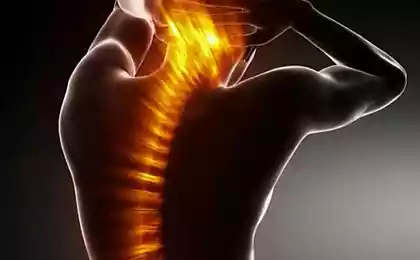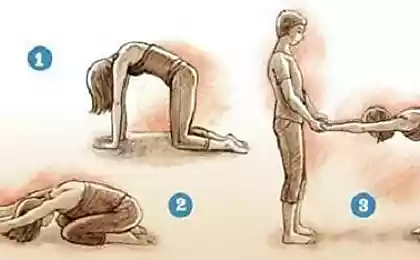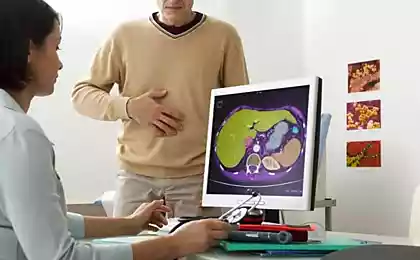454
Hernia in the lower back merely a symptom!
Does the movement experts to improve the mobility of the spine, when their client's hernia in lumbar?
In a professional environment there are two opposite approaches to this problem.
The first suggests that limiting mobility, creating a muscular unit, the body naturally builds a defense of the injured area, and increase the volume of traffic on this section in any case not necessary, because it can only do harm.
The second approach, by contrast, suggests that mobility should be improved in any way, it will help to relieve muscle spasms and to positively affect the human condition.

So what to do? Because people with problematic lower back a huge amount, and they come to us in the halls and classrooms every day!
We proceed from the understanding of the anatomy and biomechanics of movement in three planes. If you look closely at how we created our spine and to perform its capabilities, it will become obvious that the amount of motion in three planes for different parts of the spine are different.
So in the lumbar region we see a large amount of motion in the sagittal plane (flexion and extension), as well as in the frontal plane (lateral bending), but due to the shape and arrangement of the facet joints in the lumbar region there is a relatively small amount of movement in the horizontal plane (rotation). That is our lower back likes to bend over forward, backward, right and left, but not like a lot of spin.
In the thoracic volume rotary movements provided quite significant. But whether he was there for those people who come to your classes? If they have any mobility in the thoracic spine? Someone check?
Thoracic practically makes itself known, even if there is a serious lack of movement. In the thoracic vertebrae as much as 12 powerful and structurally a lot of elasticity. And if this area is not enough mobility, the resistance of the thoracic is so strong that he is able to transfer Unallocated load to it where elasticity is smaller: in the more mobile lumbar and cervical spine.
It is logical to assume, what will be the result of such compensation: problems in these areas.
And what happens below the lumbar? Let's look at the pelvis, thighs and hip joints. Not only that, we are constantly exposed to gravity, which seeks to bend us, we are in the sitting position from childhood throughout life. Almost all coaches and movement experts inevitably face in practice with the fact that their clients stiff hip joints, is sorely lacking hip extension, adduction, abduction and internal rotation in the hip joint. This vital movements that promote proper biomechanics of gait, running and any other physical activity!

the picture Futura-Sciences
The environment of the hip joint is very powerful, and if over the years there had accumulated rigidity in the absence of movement, imagine where you will go Unallocated on it load? Obviously, it will be sent in the next few movable links in the biomechanical chain to the knee joint and the lower back.
It turns out that in our body are formed in the sedentary areas, which for a long time, do not allow yourself to know the hip joints and the thoracic spine. And hypermoderne areas – lower back, knee, shoulder joints. They cheer loudly and declare themselves! On them people complain when they come to the doctor. And that they start to operate on and treat. At the Gray Institute is called treating the symptoms.
And what will be the result of treatment symptoms? We haven't solved the problem with the lack of movement in the hard areas, and hypermobile areas will continue to overload.
Back to two opposite approaches to movement if you have problems with lower back. Whether or not to improve it? And the answer is Yes and no!
The task of the coach to make the move optimally distributed. Add mobility and movement in three dimensions in those areas where traffic is not enough – thoracic, hips, feet. To provide functional stability in the lower back, working with the core muscles and oblique systems in the eccentric.

How to safely create a movement in the thoracic spine or in the hip joints and not to harm the patient lower back?
When you have tested the mobility, and found that there is a need to improve mobility of the hip joint, the chain reaction must be started from below, from a stop, and when I need to stir thoracic, run the entire chain at the top. If this important condition is not adhered to, the principle of chain reaction will play against us. The movement, launched not from the right plot will pass through the hypermobile compensation, in our case the lower back, and even more hurt instead of help distribute the traffic.
Therefore, it is important to understand what happens in the human body and how to properly use a chain reaction in training.published
In explanation of the seminar "Biomechanics Chain Reaction" Gary gray in Moscow
Talked Love Zhukovskaya
Also interesting: the Braces and hernia of the spine: what is the connection?
Hernia in the cervical spine? Learn the truth about the disease!
Source: anatomyclub.com/gryizha-v-poyasnitse-vsego-lish-simptom-v-chem-prichina-i-chto-delat/
In a professional environment there are two opposite approaches to this problem.
The first suggests that limiting mobility, creating a muscular unit, the body naturally builds a defense of the injured area, and increase the volume of traffic on this section in any case not necessary, because it can only do harm.
The second approach, by contrast, suggests that mobility should be improved in any way, it will help to relieve muscle spasms and to positively affect the human condition.

So what to do? Because people with problematic lower back a huge amount, and they come to us in the halls and classrooms every day!
We proceed from the understanding of the anatomy and biomechanics of movement in three planes. If you look closely at how we created our spine and to perform its capabilities, it will become obvious that the amount of motion in three planes for different parts of the spine are different.
So in the lumbar region we see a large amount of motion in the sagittal plane (flexion and extension), as well as in the frontal plane (lateral bending), but due to the shape and arrangement of the facet joints in the lumbar region there is a relatively small amount of movement in the horizontal plane (rotation). That is our lower back likes to bend over forward, backward, right and left, but not like a lot of spin.
In the thoracic volume rotary movements provided quite significant. But whether he was there for those people who come to your classes? If they have any mobility in the thoracic spine? Someone check?
Thoracic practically makes itself known, even if there is a serious lack of movement. In the thoracic vertebrae as much as 12 powerful and structurally a lot of elasticity. And if this area is not enough mobility, the resistance of the thoracic is so strong that he is able to transfer Unallocated load to it where elasticity is smaller: in the more mobile lumbar and cervical spine.
It is logical to assume, what will be the result of such compensation: problems in these areas.
And what happens below the lumbar? Let's look at the pelvis, thighs and hip joints. Not only that, we are constantly exposed to gravity, which seeks to bend us, we are in the sitting position from childhood throughout life. Almost all coaches and movement experts inevitably face in practice with the fact that their clients stiff hip joints, is sorely lacking hip extension, adduction, abduction and internal rotation in the hip joint. This vital movements that promote proper biomechanics of gait, running and any other physical activity!

the picture Futura-Sciences
The environment of the hip joint is very powerful, and if over the years there had accumulated rigidity in the absence of movement, imagine where you will go Unallocated on it load? Obviously, it will be sent in the next few movable links in the biomechanical chain to the knee joint and the lower back.
It turns out that in our body are formed in the sedentary areas, which for a long time, do not allow yourself to know the hip joints and the thoracic spine. And hypermoderne areas – lower back, knee, shoulder joints. They cheer loudly and declare themselves! On them people complain when they come to the doctor. And that they start to operate on and treat. At the Gray Institute is called treating the symptoms.
And what will be the result of treatment symptoms? We haven't solved the problem with the lack of movement in the hard areas, and hypermobile areas will continue to overload.
Back to two opposite approaches to movement if you have problems with lower back. Whether or not to improve it? And the answer is Yes and no!
The task of the coach to make the move optimally distributed. Add mobility and movement in three dimensions in those areas where traffic is not enough – thoracic, hips, feet. To provide functional stability in the lower back, working with the core muscles and oblique systems in the eccentric.

How to safely create a movement in the thoracic spine or in the hip joints and not to harm the patient lower back?
When you have tested the mobility, and found that there is a need to improve mobility of the hip joint, the chain reaction must be started from below, from a stop, and when I need to stir thoracic, run the entire chain at the top. If this important condition is not adhered to, the principle of chain reaction will play against us. The movement, launched not from the right plot will pass through the hypermobile compensation, in our case the lower back, and even more hurt instead of help distribute the traffic.
Therefore, it is important to understand what happens in the human body and how to properly use a chain reaction in training.published
In explanation of the seminar "Biomechanics Chain Reaction" Gary gray in Moscow
Talked Love Zhukovskaya
Also interesting: the Braces and hernia of the spine: what is the connection?
Hernia in the cervical spine? Learn the truth about the disease!
Source: anatomyclub.com/gryizha-v-poyasnitse-vsego-lish-simptom-v-chem-prichina-i-chto-delat/
Cheap low tides for facades, Windows and plinth from the manufacturer
New Li-ion battery is created from 100% silicon























